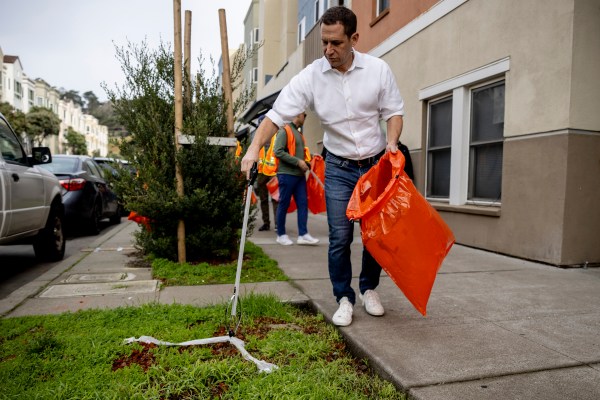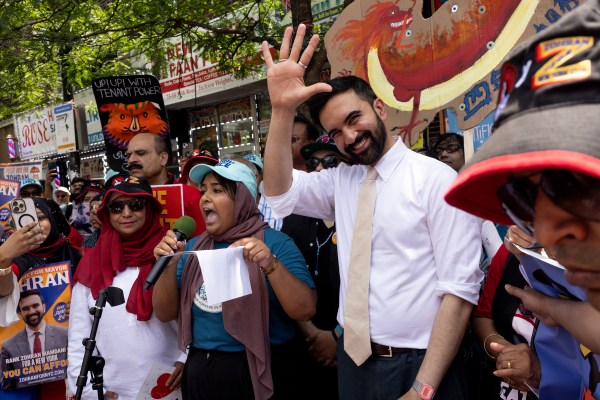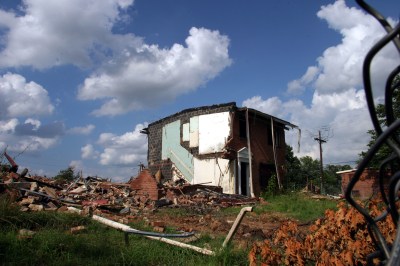Editor’s Note: This essay is adapted from The Projects: A New History of Public Housing (NYU Press, 2025) by Howard A. Husock, senior fellow in Domestic Policy Studies at the American Enterprise Institute.
Public housing in the United States, also known as “the projects,” quickly brings to mind images of high-rise towers, stories of gang violence, and physical dilapidation. These may not be universally applicable, but they are far from unfounded. In many ways, public housing today can be thought of as a modern-day poorhouse—a residence of last resort.
Nationwide, the median public household income is just $9,044. Only 15 percent of residents report income from wages—that is, from working. Not only are residents poor, but many live in poorly maintained structures. In 2019, a federal monitor was charged with overseeing the New York City Housing Authority (NYCHA), which is widely considered to be the largest and best-managed public housing system in the U.S., with 177,000 apartments on 335 sites. The monitor went on to cite NYCHA’s endemic problems with “lead-based paint hazards, heat and hot water failures, mold, elevator outages, and pests and waste.”
Residents face social ills, as well as physical ones. An analysis of New York police data has found that although residents of public housing make up only 4 percent of New York City’s population, an estimated 20 percent of violent crime, prominently shootings, occur within 100 feet of public housing. Only 3 percent of public housing households comprise two spouses with children; 32 percent are single-parent families. (The remainder are mainly the elderly poor.) It is housing not just for people in poverty but, disproportionately, racially segregated housing for the black poor: 42 percent of public housing residents are black, in a nation where they make up just 13 percent of the population.
It was not meant or expected to be this way. Public housing’s litany of social ills and management problems today obscures the public-spirited idealism bordering on the utopian that ushered public housing into American life. But such were the motivations when—as the Depression led to fundamental doubts about the private economy and its capacity to house a majority of Americans—a belief in an expanded role for a government safety net and a romance with modernist architecture and its aesthetics came together.
Before public housing became “the projects,” as even their residents would call them, the very idea of public housing was itself a project. And it was an idealistic and ambitious one at that. Those who conceived of public housing in the United States did not aim to build high-rise towers for the very poor. Their aim was to house the hardworking employed, whom they believed were being failed by private housing. But that was not all. Its early visionaries sought to change the face of cities: to replace neighborhoods they described unhesitatingly as slums and to substitute something that would be much better. They envisioned a “radiant city” of green campuses and “modern housing.” Its pastoral settings were to house a third or more of U.S. households at low rent, in buildings owned and managed by capable civil servants, rather than profit-seeking landlords they believed were cutting corners on essential maintenance and amenities.
A Chicago woman who lived in what was then the largest public housing project in the U.S.—the Robert Taylor Homes, with 28 high-rise buildings in a campus setting and home at its peak to 27,000 residents—remembered her time there from 1979 to 1999 fondly. “My childhood,” she recalled, “was fun…We knew people in just about every building… It was a family structure…It was like a village in the building.”
But the same project—demolished just 45 years after it opened—was described quite differently in a letter to the Chicago Tribune in response to a public television documentary film that highlighted its crime, drug dealing, and dilapidation. “Robert Taylor is a community within a community. . . . I have found that we are a people strangely united by the devastation inflicted upon us. . . . We are a people consisting mostly of single-parent households, headed by women. We stay only because Robert Taylor offers a way to keep our families warm in the winter and together.”
It is one thing to cut a ribbon on a new building; it was another, it turned out, to maintain and secure a project over time. The last remnants of the Robert Taylor Homes were cleared in 2007, but public housing is not past tense, even as its founding idealism has long been overtaken by its disappointing realities. Its effects linger; more than 1.6 million Americans continue to live in public housing projects. Newcomers still move in after long periods on long waiting lists; others have chosen to remain for decades, some their entire lives. Residents of more than 32,000 households in New York City public housing have lived in the projects for 40 years or more. Still others who came of age in that same public housing system—from Starbucks founder Howard Schultz to Supreme Court Justice Sonia Sotomayor—have come to understand it in a way that its originators did not intend: as a launching pad for later success.
Yet, however public housing’s effects are assessed, it is the case, without doubt, that public housing complexes are atypical for the U.S. In a country shaped by myriad private plans and investments, public housing was powered by municipal design and federal funds. In tandem with “slum clearance” powered by government takings of private buildings that provided sites for its construction, it changed the physical face of U.S. communities. Almost a century after those plans were hatched, their imprints remain: communities set off physically from their environs, populated by households selected on the basis of income by local authorities and federal rules, provided a home on the basis of their demonstrated need for one. Many of the original projects have been demolished, and some have been replaced by mixed-income developments—but their future success, too, remains uncertain. Rather than serving as a widely replicated model for the sort of mass subsidized housing envisioned by public housing’s original advocates, these new-generation projects are meant, centrally, to correct the sins of earlier ones.
Even as demolitions and smaller, differentiated types of replacements and variations have thinned the ranks of the projects, there remain 886,000 public housing “units” that are home to 1.6 million Americans. Many more would like to move in: In New York City, whose public housing system is the nation’s largest, some 263,000 households are on its waiting list. Such households are among the nation’s poorest. Some 25 percent of households have less than $5,000 in annual income, and just 6 percent earn more than $20,000. They are overwhelmingly female-headed households—either elderly single women or young single mothers with children at home.
This is a story about how this happened: how a type of building, residential living, and financial support unlike any other in the country took shape, how it rose and, in many cases, fell. It is a story central to U.S. housing policy but transcends that topic to say much about the nation’s racial politics—and housing segregation. Even more broadly, it says much about the way public policy ideas are conceived and by whom. In the case of public housing, that conception occurred not at the grassroots or even primarily among elected officials but at an apex of public intellectual thought connected to political leadership. It was not demanded by voters or conceived by builders but by essayists and ambitious architects.
There is no doubt that these efforts led, for a time and for some people, to physically better housing conditions than they might otherwise have enjoyed. This book suggests, indeed insists, however, that those who made the projects possible viewed too narrowly the “slums” that they anathematized, judging them only by their worst housing—indeed, only in terms of physical housing per se. In advocating and achieving widespread demolition of neighborhoods cleared to make way for projects, they failed to take into account the social fabric—the web of institutions and relationships—found in the communities that were literally destroyed, replaced by artificial substitutes lacking them.
Virtually no significant amount of new public housing has been built in the U.S. since 1973, when President Richard Nixon announced a moratorium that halted the highest wave of federal support for projects that had begun 24 years earlier, with the Housing Act of 1949, signed by President Harry Truman. The contrast between statements of the two presidents on the same subject can stand as bookends for the program.
In signing the National Housing Act of 1949—which would authorize construction of 800,000 public housing units, or the majority of those eventually built—Truman said this:
This far-reaching measure opens up the prospect of decent homes in wholesome surroundings for low-income families now living in the squalor of the slums. It equips the Federal Government, for the first time, with effective means for aiding cities in the vital task of clearing slums and rebuilding blighted areas. . . . The [act] establishes as a national objective the achievement as soon as feasible of a decent home and a suitable living environment for every American family, and sets forth the policies to be followed in advancing toward that goal. I take deep satisfaction in the successful conclusion of the long fight for this legislation.
In 1973, Nixon—in sharp contrast to Truman—asserted his own version of concern for the poor:
Federal programs have produced some good housing—but they have also produced some of the worst housing in America. . . . I have seen a number of our public housing projects. Some of them are impressive, but too many are monstrous, depressing places—run down, overcrowded, crime-ridden, falling apart. The residents of these projects are often strangers to one another— with little sense of belonging. And because so many poor people are so heavily concentrated in these projects, they often feel cut off from the mainstream of American life.
The drama that played out over the course of the decades between Truman and Nixon continues. America struggles with the question of which policies best encourage ”affordable housing” and whether, and how, doing so requires government subsidy. The history of public housing should be understood as a cautionary tale about an elite-driven set of choices that led to short-term improvement and long-term collateral damage.






Please note that we at The Dispatch hold ourselves, our work, and our commenters to a higher standard than other places on the internet. We welcome comments that foster genuine debate or discussion—including comments critical of us or our work—but responses that include ad hominem attacks on fellow Dispatch members or are intended to stoke fear and anger may be moderated.
With your membership, you only have the ability to comment on The Morning Dispatch articles. Consider upgrading to join the conversation everywhere.